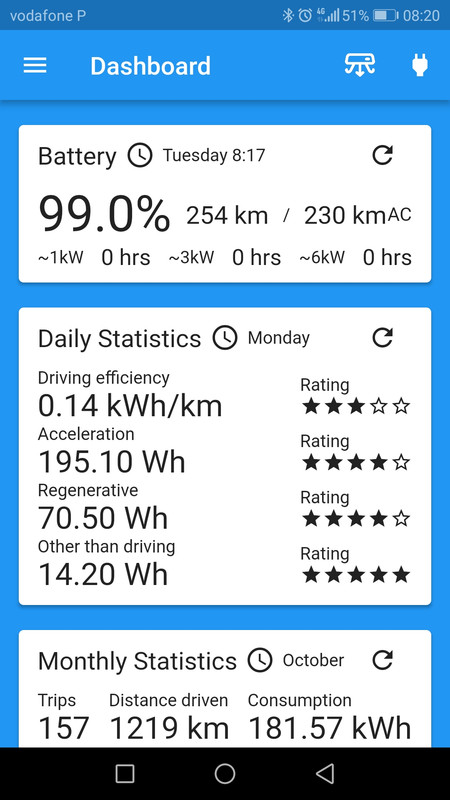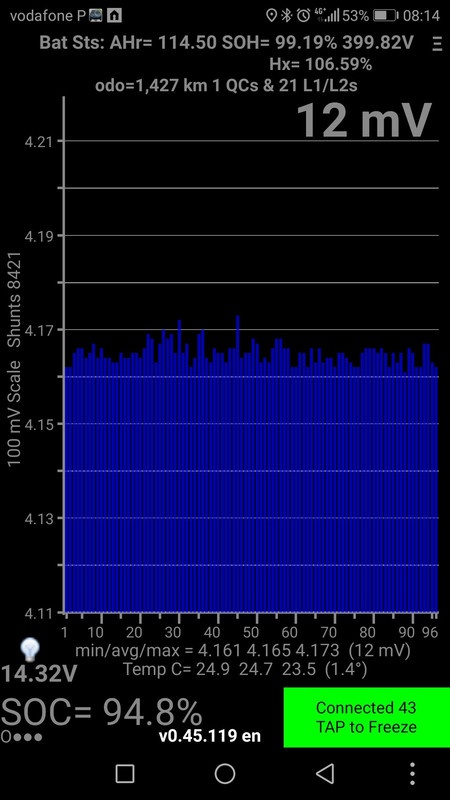Não cheguei a contar aqui que obtive uma longa resposta ao meu comentário acerca de carregar apenas a 80%. Agora, eu não estou certo que a deva citar aqui. Se parecer aos moderadores que a citação deve ser apagada, por favor. Eu cito porque é difícil encontrar um comentário num vídeo do YouTube, muito mais uma resposta, não é possível fazer um link para um comentário, e ao fim de muitos comentários os mais antigos começam a ser ocultados e após algum tempo desaparecem mesmo.
A pergunta que fiz foi a seguinte:
Miguel Ramos: Many drivers want to charge to less than 100% (say 80%) for reasons that have nothing to do with rapid charging. It's not that people don't trust car battery engineers, but people just want to go further and be super careful and prolong the battery life as much as possible. We see on most Li-Ion battery datasheets that the cycle life increases a lot when the charging voltage decreases by a tiny bit. You also read that here
https://batteryuniversity.com/learn/art ... _batteries and there's the NASA study finding 3.92V as the optimal charging voltage (for the batteries they had then). The Nissan Leaf had the option of charging to 80%. I'm ok with relaxing... But what if you use the car a lot and live in a warmer country... (i live in Portugal, btw)... Is that reasoning no longer valid?
E obtive esta resposta, que, concorde-se ou não, é boa demais para ficar perdida num comentário.
Plug Life Television: The upper SOC buffer set by most car manufacturers is a good balance between minimising degradation by reducing the maximum charge voltage, and not locking away too much of the battery's usable capacity. This is because the graph of voltage vs capacity for Li-ion cells is very steep as it approaches 100% SOC and also as it approaches 0% SOC, and is much less steep in between. Therefore, a small reduction in the maximum charge voltage does not lock away as much usable capacity as the equivalent drop in voltage at, say, 50% SOC. Tesla's engineers used this logic when setting the maximum charge voltage in their cars:
"factors affecting cycle life are tied to how the cell is used. In particular:
1. Avoiding very high and very low states of charge. Voltages over 4.15V/cell (about 95 percent state of charge [SOC]) and voltages below 3.00V/cell (about 2 percent SOC) cause more stress on the insides of the cell (both physical and electrical). Avoiding very high charge rates. Charging faster than about C/2 (two hour charge) can reduce the cell’s life.
2. Avoiding charging at temperatures below 0° C. (Our design heats the pack before charging at cold temperatures.)
3. Avoiding very high discharge rates. (Our pack has been designed such that even at maximum discharge rate, the current required from each cell is not excessive.)
There is a huge difference in cycle life between a 4.2V/cell charge (defined by the manufacturers as “fully charged”) and a 4.15V/cell charge. 4.15 volts represents a charge of about 95 percent. For this reduction of initial capacity (5 percent), the batteries last a whole lot longer. Unfortunately, further reduction of charge has a much smaller benefit on cycle life. Understanding this trade-off, Tesla Motors has decided to limit the maximum charge of its cells to 4.15 volts, taking an initial 5 percent range hit to maximize lifetime of the pack. We also limit discharge of our battery pack to 3.0V/cell and will shut down the car when the batteries reach this level."
Technically, NASA is right in that an even lower maximum charging voltage will prolong cycle life even further. However:
1. Electric vehicle battery packs have proven to be far more robust than many people previously thought, and their default maximum charging voltage has proven to be enough to minimise degradation to the extent that battery packs have surpassed the typical distance driven by a petrol or diesel vehicle before it expires (e.g. "Wizzy" the Nissan LEAF taxi which did 174,000 miles on its original battery pack, with a lot of rapid charging, and is still in regular use, and the Teslas that have driven over 250,000km with <10% battery degradation).
2. When factoring in the reduction in available capacity of the battery by setting a lower charging voltage, and therefore the increase in the number of cycles required to provide the same amount of energy as a pack that is regularly charged to "100%" (upper SOC buffer), the total energy passed through the pack before it reaches End of Life is probably reasonably similar. For example, consider two electric vehicles that achieve 4 miles per kWh, each with a 20kWh (usable) battery pack. Both vehicles drive 170,112 miles before being retired, thus each consuming 42,528 kWh over their lifetime. If the battery in the first vehicle is routinely cycled between 100% and 40%, it can travel 170,112 miles in 3,544 cycles, whereas if the battery in the second vehicle is cycled between 80% and 40%, it requires 5,316 cycles to cover 170,112 miles. Judging by the condition of battery packs in higher-mileage EVs today, the difference in the degradation of the two packs will likely be small, but the convenience of driving the first car is much higher than the second since it requires less charging sessions. Of course, if the upper SOC buffer was somehow bypassed and the battery was charged to its true 100% SOC, then you'd see a more significant reduction in cycle life and less energy passed through the pack before it reached End of Life.
3. Balancing usually only happens at 100% SOC. This is important for pack health in the long term. Whilst it isn't essential to do it after every charge, it is wise to do it about once a week or so to keep the pack in good condition.
Therefore, lowering the maximum charge voltage is essential at the cell's maximum voltage (already covered by the upper SOC buffer), but after the first 50 or so millivolts, the benefits in cycle life start to diminish. If the BMS cannot be configured to balance the pack at a lower SOC, then routinely charging to a lower SOC and never fully charging the vehicle will confuse the BMS over time and could lead to some cells getting out of balance, which is bad for pack health. For people who want the absolute extreme maximum lifespan of their battery pack, a lower maximum charging voltage/SOC is fair enough, but I still recommend occasionally charging to 100% SOC to keep the pack in healthy condition.
As for using the car a lot? Charging to 100% regularly is fine because the car won't sit at 100% for long. Li-ion batteries don't like being held at 100% SOC for prolonged periods of time - if you're going away on holiday for several weeks, leave it at around 80% SOC for minimum degradation. However, if you'll be using it within a few hours of it finishing charging, and probably won't charge it again until it's <50% SOC, then that's fine.
As for warmer climates? This is a good question. In Scotland, we don't need to worry about this too much! In very hot countries, charging to a lower SOC makes sense due to the increased rate of degradation at higher temperatures; 30 degrees C is okay (25 degrees C is ideal for performance vs lifespan), but as soon as you approach 40 degrees C ambient temperature, you want to start taking extra precautions to protect the health of the pack. Reactions happen faster at higher temperatures, and that includes degradation reactions that happen at the cathode at high voltages, so engaging Long Life Mode in the LEAF during a Portuguese heatwave might be a good idea.
However, for most moderate climates, battery degradation in EVs that are used almost daily and usually charged to 100% SOC has been low enough not to merit too much concern about the impact on health; the Battery Management System has already reduced the maximum charging voltage enough to vastly reduce degradation.
É interessante que o Hyundai Ioniq parece seguir aquela citação da Tesla: carregar até 4.15V, deixando 5% da capacidade por utilizar, no topo.
Quanto à questão de carregar a 80% resultar em menos energia por cada ciclo, é lógico. A questão é que é mais ou menos reduzir linearmente a energia de cada ciclo enquanto o número de ciclos aumenta exponencialmente... Quem souber calcular limites de sucessões... Enfim... enquanto válido... Para mim, o que continua a valer é os 3.92V do estudo da NASA. É verdade que as baterias dos carros estão a durar muito. Mas nos dias de semana, mais previsíveis, não me incomoda nada carregar a 80%. Sempre me dá alguma redenção depois dos carregamentos rápidos no fim de semana...


